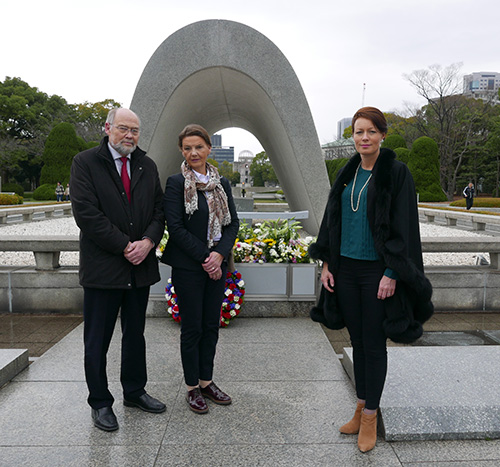
On Sunday 6 March , President of the Storting Olemic Thommessen laid a wreath at the Hiroshima Memorial Cenotaph. Photo: The Storting.
Powerful meeting with Hiroshima
The Presidium’s second day in Japan was marked by the disaster that struck Hiroshima in 1945.
Photographs from the visit. The pictures may be used freely if credited.
Having spent a day in Hiroshima, Fourth Vice President of the Storting Ingjerd Schou observed, “North Korea’s reported rocket tests in the East China Sea remind us of the importance of working for disarmament and of listening to the testimonies of eyewitnesses. The bomb that struck Hiroshima caused appalling human suffering that not only affected an entire generation but continues to mar lives through cancer and fertility issues.”
Almost 71 years have passed since American forces released an atomic bomb over Hiroshima. As part of its official visit to Japan, the Presidium, or office of the presidency in the Storting, visited the city on Sunday 6 March.
“When the A-bomb was dropped on the city, the people of Hiroshima experienced the unspeakable. Although remembrance is painful, we must not forget what happened, and must continue to recount history,” said Yasuyoshi Komizo, chairperson of the Hiroshima Peace Culture Foundation and Secretary-General of Mayors for Peace, when he met the Presidium of the Storting.

Third Vice President Svein Roald Hansen, Fourth Vice President Ingjerd Schou and Fifth Vice President Line Henriette Hjemdal in front of the Memorial Cenotaph. The Atomic Bomb Dome can be seen in the background. Photo: The Storting.
Visit to the Hiroshima Peace Memorial Museum
The bomb released over Hiroshima killed at least 120 000 people immediately, with about twice as many dying subsequently from a variety of injuries caused by factors including direct radiation and consumption of radioactive food and drink.
During their visit the presidents of the Storting visited the Hiroshima Peace Memorial Museum, which among other things exhibits photographs from 1945 and objects and clothing previously belonging to victims.
“Violent extremism is one of the problems facing the world today, making it important that people come together to identify shared values and seek mutual understanding. We must challenge the world’s leaders to make courageous decisions,” said Komizo, who guided the presidents around the museum.

Second Vice President Kenneth Svendsen and President of the Storting Olemic Thommessen at the Hiroshima Peace Memorial Dome, also known as the Atomic Bomb Dome, one of the few buildings left standing in Hiroshima after the nuclear attack. Photo: The Storting.
Meeting with a 78-year-old survivor
With Hiroshima’s mayor Kazumi Mitsui at his side, President of the Storting Olemic Thommessen laid a wreath at the Hiroshima Memorial Cenotaph.
The Presidium also had the opportunity to speak to Keiko Ogura, a survivor of the events of 1945. Ms Ogura, now 78 years old, shared her story with the presidents.
“Keiko Ogura powerfully communicated the need to consider the children. This is one of the reasons why she began to share her account of that terrible day, 6 August 1945. Working with the peace centre’s many programmes, Ms Ogura wants to teach the next generation about what happened, and that history must not repeat itself. My moving meeting with Ms Ogura was a strong reminder that knowing and engaging in dialogue with different countries is essential if we are to build shared values to ensure that 6 August 1945 never happens again,” says Fifth Vice President Line Henriette Hjemdal.
“The visit to Hiroshima and the meeting with Keiko Ogura, who was six years old when the atomic bomb killed 120 000 people in her home city instantly, are potent reminders of the terrible human and humanitarian consequences of using nuclear weapons, and impel us to continue promoting the reduction of nuclear stockpiles and, in the long-term, a consensus that nuclear arms are also weapons of mass destruction that must be banned,” commented Third Vice President Svein Roald Hansen.
The Presidents also found the time to visit the Atomic Bomb Dome, the remains of one of the few buildings not completely destroyed by the bomb and left standing as a memorial to the attack suffered by the city.
Meeting with the Prime Minister
During the course of their official visit to Japan the Presidents have attended the opening of the shop Norwegian Icons and had meetings with Norwegian and Japanese researchers and students in Kyoto.
Their programme will also include a meeting with Japanese Prime Minister Shinzo Abe, meetings with the presidents of both houses of the National Diet, and a meeting with Norwegian industry representatives. In addition, the President of the Storting will have an audience with Emperor Akihito.
First Vice President Marit Nybakk is not travelling to Japan, so that the Storting will have an Acting President in Norway.
Further reading
Last updated: 07.03.2016 15:51